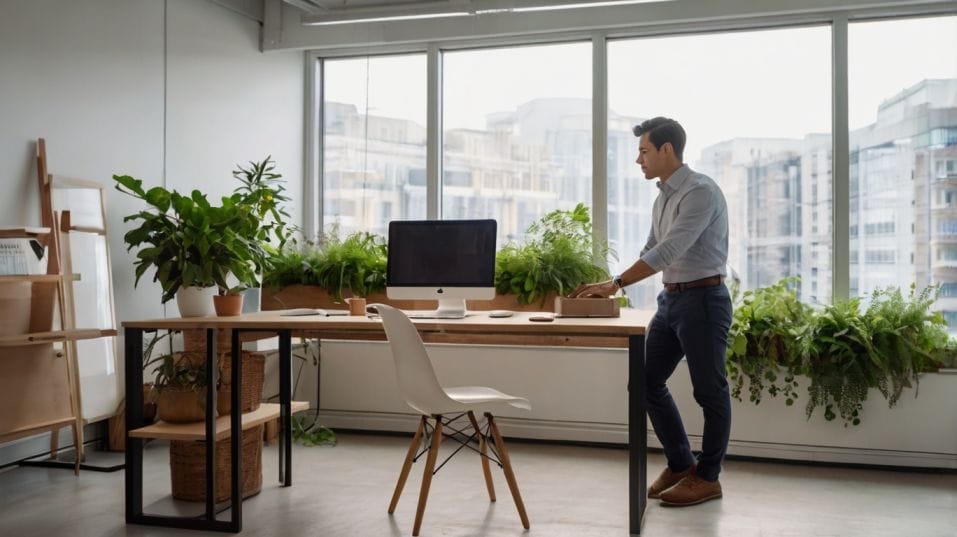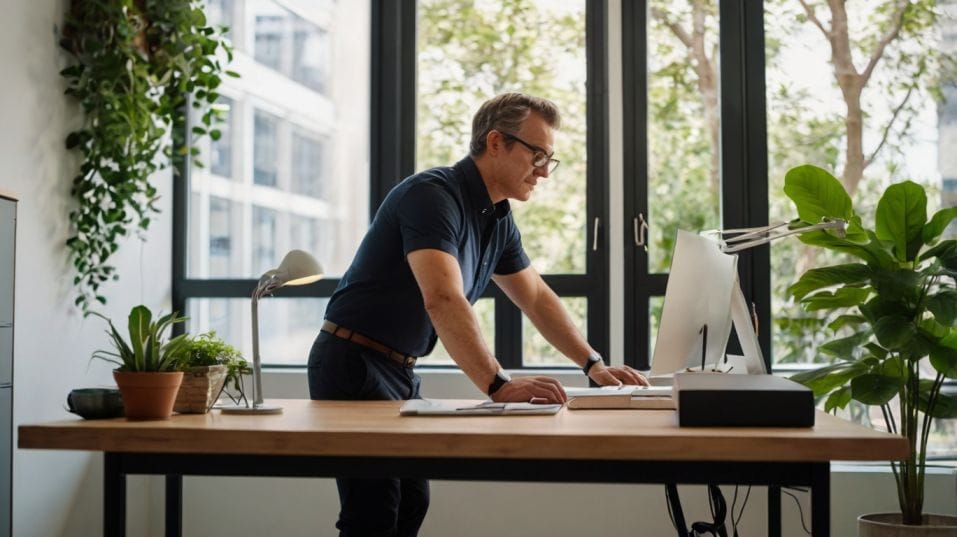Maximizing Focus and Energy with a Standing Desk and Mindful Awareness
Standing desks and mindful awareness can sharpen your focus and boost energy. Here's how to use both—without gimmicks or fluff.

Do you ever feel drained before the day’s even halfway through—despite barely moving? It might not be your workload—it could be your workstation.
Hours of sitting dull your energy and scatter your focus. But the solution isn’t just standing more. It’s learning to stand with presence.
When mindful awareness meets a standing desk, your body stays engaged, your mind stays sharp, and your workday stops feeling like a slow slide into burnout.
Rethinking the Way You Work
We’ve normalized the idea that productivity comes from grinding it out—hours planted in a chair, head down, pushing through.
But your body isn’t wired to thrive in stillness. When you sit for too long, your circulation slows, your muscles disengage, and your nervous system quietly slips into a low-energy state.
Standing, by contrast, invites subtle movement. Your legs support your frame. Your core activates to keep you upright. You naturally sway, shift, and realign. These aren’t distractions—they’re your body’s built-in tools for staying alert.
Think of it this way: standing isn’t just a different position. It’s a physiological upgrade that can help reset your energy, posture, and focus without interrupting your workflow.
But even that has limits. Because simply standing while zoning out doesn’t fix anything. You need to actually show up to the moment you’re in.
Why Mindfulness Is the Missing Link
Here’s where most people miss the point: they swap their chair for a standing desk and expect the magic to happen. But the benefits aren’t automatic.
Without awareness, standing becomes just another unconscious habit. You’re scrolling, slouching—only now on your feet.

That’s where mindfulness shifts the equation. It brings your attention back to your body and environment. It keeps you from drifting. It creates micro-moments of clarity, right in the middle of your workday.
It’s not about meditation. It’s about attention.
Try this: the next time you’re standing at your desk, pause. Feel the weight of your body pressing down into your feet. Sense the muscles in your legs holding you upright. Take one deep breath—slow and deliberate.
Then another. Let your shoulders drop. Feel yourself return to the task with a sharper edge. These small resets can make the difference between going through the motions and showing up with clarity.
The Neuroscience of Movement and Focus
Movement and mental clarity aren’t separate—they’re deeply intertwined.
Studies in Frontiers in Psychology have shown that light physical activity can enhance executive functioning—the brain’s high-level processes like decision-making, task-switching, and sustained attention.
This isn’t about hitting the gym mid-shift. Just standing, adjusting your stance, or stretching briefly can stimulate the parts of your brain responsible for clarity and focus.
When your body is engaged—even slightly—your brain follows suit. Think of your nervous system like a dimmer switch: movement gradually turns the lights back up.
Even small gestures matter. Shifting your weight. Rolling your shoulders. Standing tall instead of collapsing into your hips.
These movements re-energize your system without disrupting your workflow. They’re subtle, but they break the pattern of physical stagnation that leads to mental fog.
And crucially, pairing these movements with awareness amplifies the benefits. It turns passive posture into an active tool for staying grounded and alert.
Rewiring Your Workday in Real Time
You don’t need a brand-new setup or a radical schedule change to make this work. You need intentionality.
Start with your physical space. Keep your monitor at eye level so your neck stays aligned. Stand with your feet shoulder-width apart and your weight balanced.
If you’re on your feet for longer periods, an anti-fatigue mat can ease strain—but what matters more is how you stand.
From there, layer in mindfulness. Not as a separate activity, but as part of how you move through your day.
When you feel tension rising or attention fading, that’s your cue. Take one full breath. Stretch your arms overhead. Reset your posture.
Instead of pushing through fatigue or reaching for another coffee, give your body the micro-movement and mental pause it’s asking for.
This isn’t about forcing discipline—it’s about responding to your body with awareness.
And when you transition between tasks, resist the urge to immediately shift gears. Take a minute to breathe. Let your nervous system settle before diving into the next challenge.
You’ll bring more presence to each moment—and that presence compounds over the course of a day.
Turning Your Desk Into a Tool for Awareness
What you’re building isn’t just a better ergonomic setup—it’s a feedback loop. The standing desk reminds you to check in with your body.
The mindful moments reinforce better posture. The energy boost reinforces the habit. Over time, this becomes second nature.
The deeper benefit? You start reclaiming agency over your day.
Instead of being pulled along by urgency and distraction, you anchor yourself in awareness. You notice when fatigue hits and respond.
You sense when stress builds and reset. You catch yourself drifting and re-engage—before hours slip away.
It’s a mindset shift as much as a physical one: from passive endurance to active presence.
Why It All Matters
This approach isn’t just about avoiding pain or improving posture. It’s about cultivating resilience in the middle of real work.
You deal with deadlines, meetings, mental load, and constant context switching. Focus isn’t always easy to come by. But when your body and mind are in sync, you create the conditions for clarity to emerge—consistently.
Mindful standing helps you stay sharp during deep work, shake off mental fatigue before it spirals, and manage your energy more intelligently throughout the day.
It’s not a gimmick. It’s a practical upgrade to how you operate. And once you experience it, going back to slumped-in-a-chair autopilot starts to feel like wearing shoes on the wrong feet.
Final Thoughts
If you’re waiting for the perfect productivity tool, stop. You already have one: your body.
Start now. Stand for your next call. Roll your shoulders. Take one conscious breath. Anchor into the moment. Let that small shift ripple outward into your next task, your next hour, your entire day.
You don’t need more willpower. You need awareness. And that begins not with a breakthrough, but with a breath.




